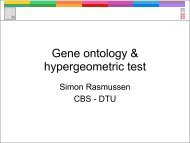Computational tools and Interoperability in Comparative ... - CBS
Computational tools and Interoperability in Comparative ... - CBS
Computational tools and Interoperability in Comparative ... - CBS
Create successful ePaper yourself
Turn your PDF publications into a flip-book with our unique Google optimized e-Paper software.
<strong>Interoperability</strong><br />
Figure 4.1: Screen shot of NCBI Entrez Genome projects web page<br />
Services, an <strong>in</strong>teroperble life science community may not be far away. When connected,<br />
the communities will be able to exchange not only data but many services such as <strong>tools</strong><br />
for predict<strong>in</strong>g prote<strong>in</strong> function, perform<strong>in</strong>g sequence alignments, or gene f<strong>in</strong>d<strong>in</strong>g.<br />
4.2 <strong>Interoperability</strong><br />
”The term ’<strong>in</strong>teroperability’ is def<strong>in</strong>ed as the ability ... <strong>in</strong>formation, by IEEE (http...)”.<br />
The term ’<strong>in</strong>teroperability’ is def<strong>in</strong>ed as the ability of two or more systems to exchange<br />
<strong>and</strong> make use of <strong>in</strong>formation (IEEE, http://www.ieee.org). Whether systems can be<br />
said to be ’<strong>in</strong>teroperable’ depends on how one <strong>in</strong>terprets ’make use of’. Consider the list of<br />
full prokaryotic genome sequences, ma<strong>in</strong>ta<strong>in</strong>ed by NCBI at http://www.ncbi.nlm.nih.<br />
gov/genomes/lproks.cgi, as shown <strong>in</strong> figure figure 4.1.<br />
To automatically retrieve this list, one may write a parser to transform the HTML<br />
<strong>in</strong>to a computer-readable text. Apart from be<strong>in</strong>g overly sensitive to changes <strong>in</strong> the HTML<br />
document, such a parser will lack the knowledge beh<strong>in</strong>d the data s<strong>in</strong>ce the format is not<br />
typed nor structured. It is only when <strong>in</strong>terpreted by an <strong>in</strong>ternet browser <strong>and</strong> presented<br />
graphically to a human, that this <strong>in</strong>formation makes any sense. Both recipient <strong>and</strong> receiver<br />
must <strong>in</strong> other words have knowledge about the <strong>in</strong>formation that is exchanged, before these<br />
can be said to be <strong>in</strong>teroperable. The are two aspects of <strong>in</strong>teroperability: First, there must<br />
exist agreement on the format by which data is exchanged. Whether this is structured<br />
XML or any arbitrary format, the server must return the format expected by the client<br />
upon a request. Second, the description <strong>and</strong> underst<strong>and</strong><strong>in</strong>g of the content of the data be<strong>in</strong>g<br />
exchanged is a requirement when build<strong>in</strong>g client-side code <strong>and</strong> objects <strong>in</strong> Web Services.<br />
Without the knowledge of exact data types, the programm<strong>in</strong>g environment (e.g. C, Java,<br />
Perl) fails to declare the objects with proper variable types.<br />
146









